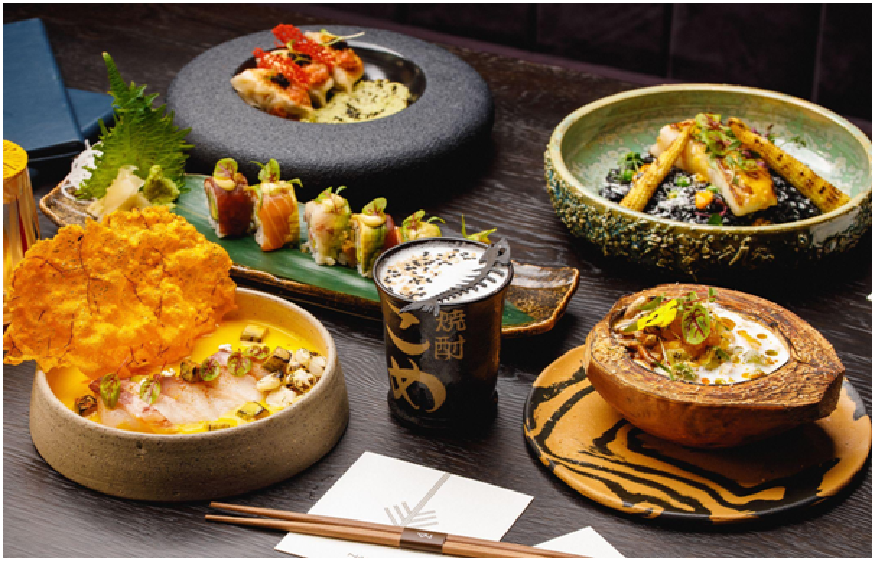 Traditional Japanese cuisine uses visual presentation and seasonal food elements from the millennia of its culinary development. The simplicity of Japanese cuisine presents natural flavors while rejecting excessive seasoning which creates its beauty. Each simple Japanese dish undergoes precise presentation so that it becomes an artistic masterpiece. Japanese culinary principles establish that ingredients need proper respect and that all processing should aim to reveal their authentic qualities through minimal handling methods. This worldwide famous nutritious meal consists of fresh fish, rice veggies, and seaweed as its basic ingredients.
Traditional Japanese cuisine uses visual presentation and seasonal food elements from the millennia of its culinary development. The simplicity of Japanese cuisine presents natural flavors while rejecting excessive seasoning which creates its beauty. Each simple Japanese dish undergoes precise presentation so that it becomes an artistic masterpiece. Japanese culinary principles establish that ingredients need proper respect and that all processing should aim to reveal their authentic qualities through minimal handling methods. This worldwide famous nutritious meal consists of fresh fish, rice veggies, and seaweed as its basic ingredients.
The typical Japanese diet extends well beyond sushi, featuring numerous diverse culinary options. Traditional Japanese food emphasizes cooking approaches that have developed over time to enhance flavor while retaining nutrients. Methods such as steaming, grilling, and simmering help maintain light yet satisfying dishes, delivering harmonious flavors that respect the original characteristics of each ingredient.
Regional Differences in Japanese Cuisine
Different territories of Japan produce distinctive regional culinary traditions because of their varied geographical characteristics. The people living in northern regions prepare many preserved foods along with warming and filling recipes as their primary winter sustenance. The food in southern Japanese regions differs from the north by offering mild cuisine consisting mainly of fresh seafood and vegetables. Meals in mountain villages come from local vegetables combined with mushrooms and wild plants but coastal regions prepare their dishes from seafood components.
Hokkaido earns recognition through its rich and flavorful soups together with its exceptional aquatic food and its creamy dairy products. The Kansai region holds Osaka and Kyoto as part of its territory and presents cuisine with refined tastes and gentle spice combinations. Tokyo in the Kanto region presents a combination of traditional regional foods with modern influences from multiple traditional styles. All Japanese regions embrace their local culinary traditions because these dishes emerge from localized historical eating habits and native local ingredients available in their regions. The diverse nature of Japanese culinary culture provides fresh dining experiences throughout every visit to the country.
Key Components of a Classic Japanese Snack
Traditional Japanese dinner requirements include following particular styles and submission rules. Dinner normally includes rice along with pickles in combination with the ichiju-sansai principle (one soup and three sides). All ingredients serve to create harmonious proportions that extend beyond dietary aspects to include the perfect combination of flavors together with textures and color contrasts. Each bite remains individual because both the chef and the diner place them on their small dishes and bowls.
Japanese cuisine bases its operation on the yearly variations of food seasons. At shun chefs pick their ingredients fresh to obtain more delicious and nourishing results. The excitement builds because the yearly addition of new culinary choices allows diners to enjoy the freshest seasonal foods. The restaurant offers a yearly schedule of new menu offerings which provides consistent eating variety for customers while linking their meals to natural time cycles.
Locating Reasonably Priced Japanese Dining Options in Dubai
Dubai serves as an excellent choice for trying authentic Japanese food away from Japan because it has welcomed international dining culture. The city offers multiple dining spots where customers can enjoy authentic Japanese food within their set budget. An affordable Japanese restaurant Dubai maintains quality at reasonable prices by focusing on well-established dishes rather than an extensive menu.
Most affordably priced Japanese dining outlets in Dubai serve residents instead of catering to tourists or high-class shoppers who visit upscale shopping malls. Unknown tourist destinations provide visitors with an authentic dining experience because they tend to be less expensive. Some shopping malls possess food courts where customers can dine at traditional Japanese restaurants without spending excessively on meals. The lunch specials at certain restaurants provide patrons with an opportunity to experience traditional Japanese dining during the daytime at reduced costs.
What to anticipate at a genuine Japanese eatery
An authentic Japanese setting within the restaurant transports its guests to feel like they are in Japan. Japanese design elements appear through minimalist and uncluttered decoration that integrates natural elements. Japanese traditional restaurants usually maintain tatami mats in seating areas in combination with wooden elements and minimal decorations. Customers benefit from the peaceful atmosphere because it helps them focus on their dining comfort.
Guests receive the invitation “irasshaimase” from the staff ahead of starting their meals. Staff members at the restaurant will offer hot towels for handwashing before serving food. The service style creates deferential and detailed service but does so without creating overwhelming situations. Restaurants arrange food service in a specific order to enhance flavor development and their staff lets guests eat independently unless they need further clarification.
Well-liked Traditional Japanese Foods You Should Try
Rice acts as an essential ingredient in Japanese cooking since it appears in nearly all dishes. Short-grain Japanese rice calls for chopsticks as perfect eating utensils because of their sticky consistency. The study of traditional Japanese cuisine requires testing multiple rice preparations because they illustrate how the Japanese people consume their food daily. The assortment of these recipes shows the various ways rice can be cooked including basic steamed rice and versions with additional additions.
Japanese cuisine frequently serves miso soup which combines dashi broth with soybean paste and various vegetables and tofu and seaweed components. The warming comfort of this traditional soup leads to many Japanese meals. Japanese cuisine features grilled fish presented whole as the elements of natural taste speak for themselves. Fresh seafood gains its best taste through basic cooking methods.
Nimono consists of meat and tofu ingredients along with vegetables that require slow boiling in savory broth until they properly take on flavor from the liquid. A perfect demonstration of how Japanese culinary practices get maximum flavor out of simple ingredients exists in these recipes. The Japanese traditional preserved foods known as tsukemono serve as refreshing and sour pieces which assist in digestive processes and refresh the palate during meal times.
Conclusion
The philosophical meaning of traditional Japanese cuisine manifests itself through different culinary methods as well as eating preferences. Japanese culinary practices under the umbrella term washoku deliver food prepared by respecting natural cycles while honoring the relationship between humans and nature. Traditional Japanese eating represents eating as a fundamental connection between humans and nature and cultural heritage while accommodating nourishment. Knowledge about these ideas helps people appreciate traditional Japanese food better.
Traditional Japanese cooking obtains its distinctive qualities by utilizing the fifth taste category named “umami” which exceeds the traditional four tastes. Traditional Japanese cuisine includes multiple foods which possess the delicious taste component commonly found in fermented soybeans dashi and select vegetables. The study of umami flavors helps people grasp the refined complexities within traditional Japanese traditional food preparation. Japanese eating culture centers around mindfulness because people are supposed to commit full attention to their food at mealtime while experiencing both taste and visual appeal.









